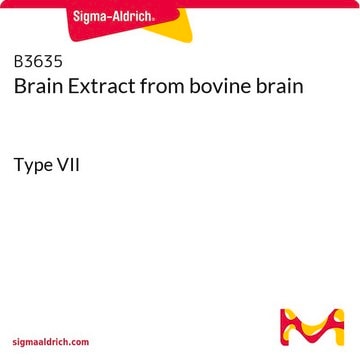B7906
1-Butanol
for molecular biology, ≥99%
Synonim(y):
n-Butanol, Butyl alcohol
About This Item
Polecane produkty
klasa czystości
for molecular biology
gęstość pary
2.55 (vs air)
ciśnienie pary
5 (4 mmHg) at 20 °C hPa
Próba
≥99%
Postać
liquid
temp. samozapłonu
649 °F
granice wybuchowości
11.2 %
kolor
colorless
współczynnik refrakcji
n20/D 1.399 (lit.)
pH
7 (20 °C, 70 g/L)
tw
116-118 °C (lit.)
mp
−90 °C (lit.)
gęstość
0.81 g/mL at 25 °C (lit.)
temp. przechowywania
room temp
ciąg SMILES
CCCCO
InChI
1S/C4H10O/c1-2-3-4-5/h5H,2-4H2,1H3
Klucz InChI
LRHPLDYGYMQRHN-UHFFFAOYSA-N
Szukasz podobnych produktów? Odwiedź Przewodnik dotyczący porównywania produktów
Opis ogólny
Zastosowanie
- in the derivatization process for measuring methylated arginine levels in blood samples
- in liquid-chromatography mass spectrometry (LC-MS) analysis of lysine modifications by deacetylase CobB
- in the extraction of plant material from Vigna unguiculata
- to extract and purify amplified human DNA samples before further amplification by PCR followed by sequencing
1-Butanol is suitable for use in nucleic acid purification and concentration protocols.
produkt powiązany
Hasło ostrzegawcze
Danger
Zwroty wskazujące rodzaj zagrożenia
Zwroty wskazujące środki ostrożności
Klasyfikacja zagrożeń
Acute Tox. 4 Oral - Eye Dam. 1 - Flam. Liq. 3 - Skin Irrit. 2 - STOT SE 3
Organy docelowe
Respiratory system
Kod klasy składowania
3 - Flammable liquids
Klasa zagrożenia wodnego (WGK)
WGK 1
Temperatura zapłonu (°F)
95.0 °F - Pensky-Martens closed cup
Temperatura zapłonu (°C)
35 °C - Pensky-Martens closed cup
Środki ochrony indywidualnej
Eyeshields, Faceshields, Gloves, type ABEK (EN14387) respirator filter
Certyfikaty analizy (CoA)
Poszukaj Certyfikaty analizy (CoA), wpisując numer partii/serii produktów. Numery serii i partii można znaleźć na etykiecie produktu po słowach „seria” lub „partia”.
Masz już ten produkt?
Dokumenty związane z niedawno zakupionymi produktami zostały zamieszczone w Bibliotece dokumentów.
Klienci oglądali również te produkty
Nasz zespół naukowców ma doświadczenie we wszystkich obszarach badań, w tym w naukach przyrodniczych, materiałoznawstwie, syntezie chemicznej, chromatografii, analityce i wielu innych dziedzinach.
Skontaktuj się z zespołem ds. pomocy technicznej











